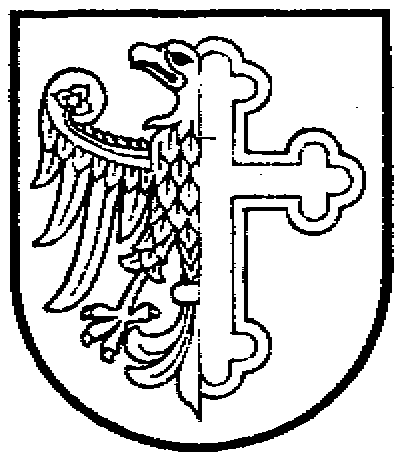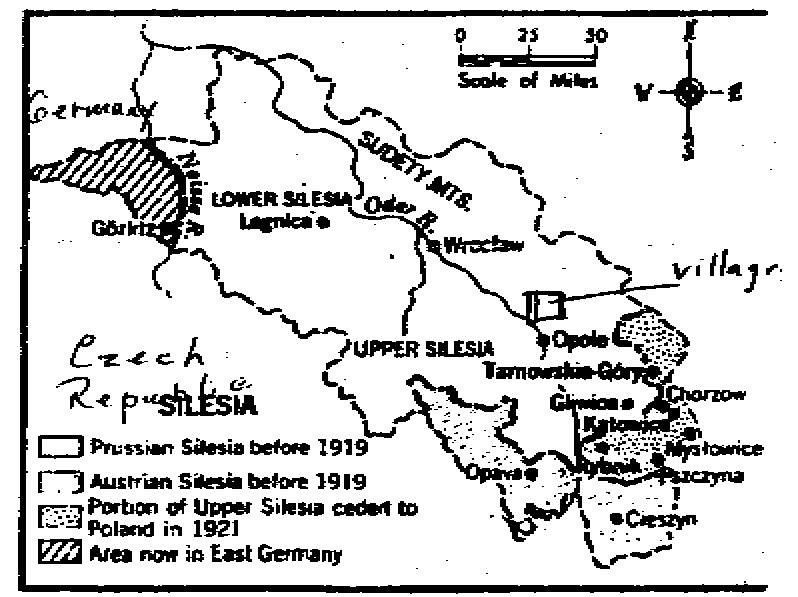Silesia to America -- A Heritage: Polish Silesian Settlement in Central Minnesota by Robert Prokott |
Newspapers of the latter 1800's referred to them as "Polanders." These new settlers in the southern part of Morrison County came from the Opole province of Upper Silesia in what is now southwestern Poland. The Silesians were part of the Polish Nation from the date of its founding in 966 A.D. and remained under the rule of the Piast princes until 1335 when Casimir III the Great gave up claims to Silesia and recognized it as part of the kingdom of Bohemia. Silesia retained an essential link to Poland in that its archbishopric at Wroclaw remained subordinate to the Primate at Gniezno, but political rule of Silesia passed to the kingdom of Bohemia. In 1526, Silesia, along with Bohemia and Moravia, came under the rule of the Hapsburgs. Silesia was part of the Hapsburg Monarchy for over 200 years until the war of the Austrian Succession. By the Treaty of Breslau in 1741, all of Lower Silesia and most of Upper Silesia came under the Prussian rule of Frederick the Great. Prussian rule ultimately became German rule and Silesia remained under German rule until 1945. Following World War II it again became a part of Poland and so remains to the present time. Opole is the chief City in Upper Silesia while Wroclaw (called Breslau by the Germans) is the historic capital of Lower Silesia. The Prussian government made no serious attempts to suppress the cultures and language of the area until Bismarck came into power. In the 1860's under Bismarck's rule, school instruction was required to be in the German language. Bismarck also felt that the Pope in Rome was a threat to his rule and attempted to suppress the Catholic faith of Silesia. These actions, along with poor economic times and letters from Father Xavier Pierz that extolled the virtues of central Minnesota, led to a large migration to America. The people who came to Morrison County in Minnesota were farmers who had lived to the north of the city of Opole in Silesia. The first to arrive was John Schwintek, along with his wife Margaret and sons Frank, Albert, and John. They arrived in New York on June 15, 1870 and took the train to St. Cloud. They then went to the vicinity of North Prairie and settled in Two Rivers Township. They were followed by friends and relatives, most of whom came from the parishes of Falkowice (Falkowitz in German), Stare Siolkowice (Alt Schalkowitz), and Dobrzen Wielki (Gros Dobern), all located in the farming area to the north and northwest of the City of Opole (Oppeln in German). Essentially all of the Silesians who came to central Minnesota were farmers. They initially settled in Two Rivers Township, near North Prairie. North Prairie originally was located in the northeast corner of Stearns County, about four miles from its present location in Morrison County. The area was a small strip of land on the western bank of the Mississippi and was initially know as the "German Settlement." By 1866 the number of families had increased to about 20, mostly farmers of German nationality. In 1866, Jacob Turner offered to sell 40 acres of land to the Catholic Church for $50. This offer was accepted and a small church with floor space of about 18 by 24 feet was built. This was built at the location in Morrison County of what is presently North Prairie. The North Prairie Post Office had been established in 1867 on the homestead of William McNeal in northeastern Stearns County. In 1873 the post office was moved to the present North Prairie location in Morrison County and the name, German Settlement, disappeared and was thereafter known as North Prairie.
In the years through 1880, an agriculture census was taken every 10 years. The 1880 census indicated that a typical farm in Morrison County would consist of a total of 80 acres of which about 70 acres would be woodland and forest, eight acres of tilled land, and two acres of permanent pasture, meadow, etc. Each farmer had either two working oxen or work horses, one to two cows, one or two swine, and 15 to 20 chickens. The tilled acres were planted in wheat, oats, barley, and potatoes, with annual production of perhaps 100 bushels of wheat, 25 bushels of oats, 10 bushels of barley and 10 to 20 bushels of potatoes. As indicated earlier, the first people from Silesia came in 1870. By 1880, there were over 60 farmers from Silesia living in Two Rivers Township and over 20 in Swan River Township -- both townships in Morrison County. Additional persons from Silesia had established farms in Brockway Township and Holding Township in the northern part of Stearns County, east and south to Elmdale and Sobieski as well as Flensburg in Morrison County. They also moved east of the Mississippi River to settle much of Langola Township in southwestern Benton County as well as much of Bellevue Township and he Village of Royalton in Morrison County. To the present time, many of the farms in these areas are being operated by the descendants of the immigrants who came here from Silesia over a century ago. The settlement in Morrison and Stearns County was the largest settlement of Silesian Poles in Minnesota. Other settlements of Silesians in Minnesota include Browerville, Delano, Perham, and Ivanhoe area of southwestern Minnesota. Another large group of Silesians came to Trempealeau County in and around Independence, Wisconsin. This area is located northeast of Wonona, Minnesota. Many farmers in that area at the present time are descendants of the Silesian Poles who came to America over 100 years ago. Listed below are surnames of some people who emigrated from the Opole region of Silesia: Baron, Barton, Benusa/Bieniusa, Bieniek, Blasczyk, Bobick/Bobik, Boros/Borasch, Brenny, Bursey/Bursy, Bzdok, Cekakka/Czekala, Cichon/Cichy, Czech, Dombovy/Dombowy, Doschka/Doska, Dubiel, Fabian, Fautsch, Filip/Philip, Filla, Fussy, Gaida, Gallus, Gamroth, Gmyrek, Golla, Harmans/Harmanza, Hyla, Jagusch, Jakubik, Jambor, Janek, Janey/Jany, Janish, Janski, Jendro, Jendrysek, Jesok/Jezok, Jonietz, Kalis, Kampa, Karasch, Kasella, Kasparek, Klimek, Klisch/Klescz/Klyszcz, Kloss, Kokott, Kolodziej/Kollodge, Karoll, Kostreba, Kowalczyk, Kroll/Krol, Krystosek, Kuka, Kuklok, Kulig, Kulla, Kupka/Kopka, Langer, Lasota, Lempart, Lempka, Maciej. Manka/Mainka, Marsolek, Masog, Matros, Misch/Mish/Mis', Moczko/Motzko, Mrosek, Mrosla/Mrozla, Opatz/Opacz, Palluch, Pierzina, Pietrick, Pietron/Petron, Pietrzak, Pintok/Pientok, Pogrzeba, Pollok, Posch, Prokott/Prokopp, Przybilla, Psyk/Psyck, Puchalla, Pyka/Peka, Radziej, Rossa, Roszczek, Rudek, Scepurek/Szczepurek, Scheitza/Shietza, Schelonka/Zielonka, Schibilla, Schlichting/Szlichzin, Schwientek/Swintek, Skroch, Smieja, Sobania, Sobiech, Solorz/Szolors, Sowada/Zowada, Soyka/Sojka, Speda/Spieda, Stanek, Stellmach, Stiller, Stodolka, Sura/Szurra, Surma, Suska, Switalla, Symalla/Szymala, Tomala/Tomalla, Trettel, Trutwin, Urban, Walek/Wollak, Waletzki, Waletzko, Warzecha, Wavarek/Wawarek, Welna, Wiatrak, Wieczorek, Wilczek, Wochnick, Wodarz, Wojtaszek, Wrobel, Yorek/Jorek/Jurek, Yourczyk, Zur, Zwack/Czwak. |
|
1. Reprinted from the Polish Genealogical Society of Minnesota's WCGS Newsletter with author's
permission, Winter 1996-97, Vol. 14 No. 10, p. 8-9.
2. The official crest from the city of Opole. Source: Andrzej Plewako and Jozef Wanag, "Herbarz Miast Polskich," 150. A copy of this work is available in the Polish collection at the MGS Library. The majority of the Silesians that settled in Central Minnesota came from rural villages near Opole. Many rural Silesians maintained their Polish language despite the fact that Silesia was formally separated from the Polish state for over 600 years. In fact, Polish is still spoken in Central Minnesota by some descendants of these Silesian immigrants. The following was translated from "Herbatz" by W. Kornel Kondy: OPOLE (Provincial capital). Received its charter in the year 1234. The city's name originates from the word opole which refers to the territory of the ancient Slavic community (this was the capital of the Opolan tribe). The crest is divided vertically in the center. The right half is represented by half a golden Upper-Silesian eagle; the left with half a gold cross on a field of azure. The crest is in keeping with the tradition of the capital of the Duchy of Upper-Silesia, which whilst the cross symbolizes the relic of the Holy Cross, located in the first parish church. This heraldic device was employed on 14th century seals and coins. 3. Map from Encyclopedia Americana 1986 ed., a.v. "Silesia." Poland has regained most of
historical Silesia. Exceptions are the Opava and Cieszyn areas which are in the Czech Republic
and the area west of the Neisse River which is in Germany. This map shows that even
encyclopedia makers make mistakes. The Sudety Mountains are along the southwestern border
with the Czech Republic and not where indicated on this map. |
|
Copyright by Robert Prokott, used with permission. Data Entry Volunteer: Ron Zurek Updated 10 Oct 2019 by William Haloupek |



